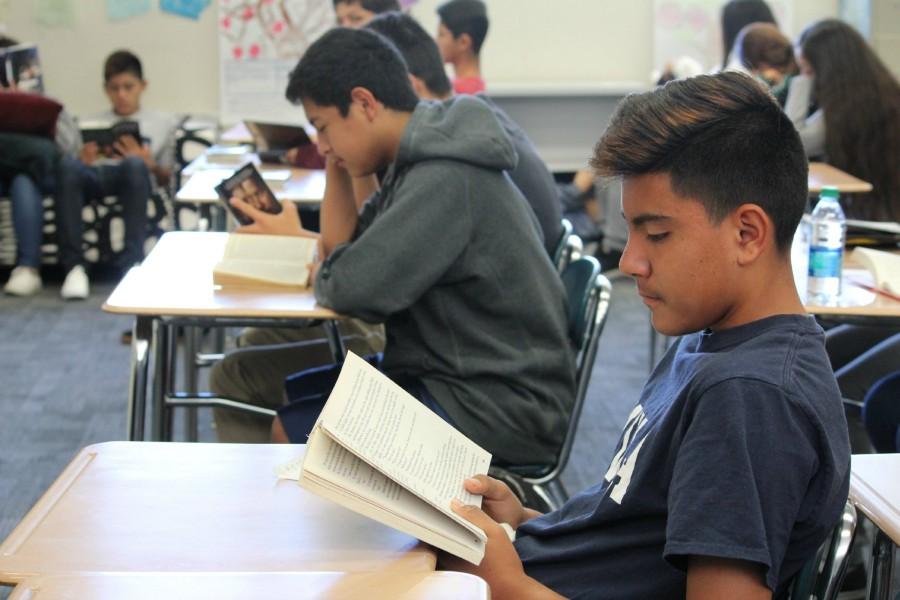School Replaces World Literature Skills Class with English 10
Starting this year, the school is offering a new English 10 class in place of the previous sophomore English support class, World Literature Skills. Taught by English teachers Carrie Abel and Elizabeth Tompkins, English 10 is a double-period course, meaning enrolled students will spend two periods in a row in the same class.
Previously, students in World Literature Skills would spend more time covering the content from the World Literature class. Currently, students in English 10 are learning from a different curriculum than the World Literature classes and participating in different activities.
“The difference is… that [skills classes] would often be supporting the mainstream curriculum in terms of helping write the essay for that class or reading,” Tompkins said. “This year in English 10, we also extend some of that reading and writing time into the double period, but we often also reserve part of that other period for independent reading, for goal setting, for focused grammar lessons and things like that.”
Skills teachers usually base their lesson plans off what the World Literature classes are learning, but Abel and Tompkins believed this model was ineffective for World Literature Skills.
“We wanted… a course that would help students continue developing their reading and writing skills once they got to their sophomore year, and we were not convinced that the current model [of World Literature Skills] was working,” Tompkins said.
One of the main objectives of English 10 is to have students practice their writing through a recursive process. Because the class is a double period, the teachers have built in revision time within the allotted double period in which students are able to obtain feedback and rewrite their pieces.
“In a lot of ways it is similar to other classes,” Tompkins said, “It is building reading skills [and] writing skills, but one of the main ways… this course [is] really different is that we require more revision than I personally have [ever] required in other courses I have taught,” Tompkins said.
Other objectives of the class include building literacy, close analysis and vocabulary.
“Research is showing that when you read a book that is at your lexile level… and it is a book you have personal investment in, your reading and vocabulary will… go up naturally because you are constantly practicing engagement… of appropriate text for yourself,” Tompkins said.
The English 10 class has 25 students this year in each of its two sections. Students in the class are selected based on their performance in freshman English, and English teachers meet with each of the students before enrolling.
“Everyone would benefit from a double period English class… whether you are an A student or you are failing,” Abel said. “But [the class] is not designed for all students. With [limited] resources… we cannot have unlimited amounts of students in the class, so we hand-select the students that will be enrolled into English 10.”
Because English 10 offers both elective and English credit the student selection for this class and other skills classes is different from that of a regular class to avoid issues surrounding limited space.
For English classes, the books read are selected by the teachers of the course, and since English 10 has only two teachers, its book selection is more flexible. So far, the students have read “Ender’s Game” and “Always Running” and also have their own independent reading selection.
“There are no books you have to read in 10th grade, so we have the freedom to create a curriculum that allows students to either enter World Literature or American Literature next year,” Abel said.
The class usually begins with independent free choice reading for 20 minutes, followed by a directed response to specific elements of the reading. The students transition into the book they are reading as a class and engage in discussion questions. Along with reading analysis and questions, students have joint class activities such as class competitions or projects such as the community awareness project.
Before being formally proposed, the proposed class was discussed with English teachers and school administration. It was then passed on to the leadership team, made of all department coordinators, elected staff members and administration to discuss the logistics at large. After the team approved the proposal, they passed it on to the district, which was the final step to set up the class.
“We prefer [that] the ideas [for new classes] for the following year start in October,” Assistant Principal Perla Pasallo said. “We like to have it done at least by the February of the year before, but we have had people find out about things later and bring it up out of sequence… and if it is in the benefit of kids, [we] go for it.”
The process for creating a new class can span over a short period of time once approved by the local school members involved, but when the class is implemented is dependent on how long the district takes to approve the idea. The average time that passes between the formation of an idea and the district’s approval and implementation is from six to ten weeks.
“Ms. Abel and I spent most of the summer designing it, getting it A-G approved,” Tompkins said. “But that would only be the first period of my class… and the second class [is] an elective on your transcript.”
The English 10 teachers stress the strong sense of community they hope to foster through this program and the brilliance of the students involved in the course to shine through.
“What I do not want is for Skills students to be this extra entity that no one really knows about,” Abel said. “I think it is always good for kids to know that we have a diverse student body, many that are students who were born and raised in the U.S. but grew up speaking a different language at home… Knowing that is something we should value instead of hiding it away.”
Both teachers have previous experience teaching skills classes, but they look forward to teaching English 10 for the rest of the year.
“This course has just been so fun to teach… I love it,” Tompkins said. “[The] students are incredibly engaged and they are creating great work… The energy in this room is really good.”





